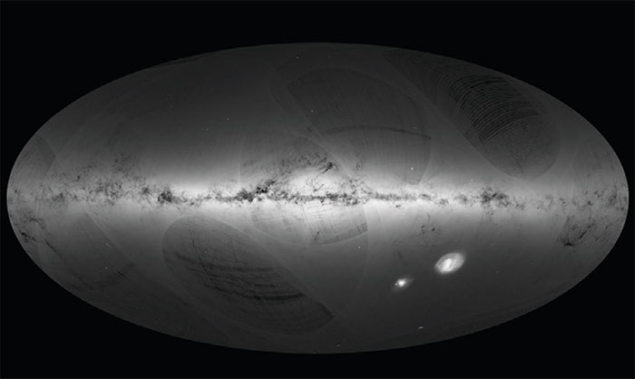
Image credit: ESA/Gaia/DPAC.
The largest all-sky survey of celestial objects has been compiled by ESA’s Gaia mission. On 13 September, 1000 days after the satellite’s launch, the Gaia team published a preliminary catalogue of more than a billion stars, far exceeding the reach of ESA’s Hipparcos mission completed two decades ago.
Astrometry – the science of charting the sky – has undergone tremendous progress over the centuries, from naked-eye observations in antiquity to Gaia’s sophisticated space instrumentation today. The oldest known comprehensive catalogue of stellar positions was compiled by Hipparchus of Nicaea in the 2nd century BC. His work, which was based on even earlier observations by Assyro-Babylonian astronomers, was handed down 300 years later by Ptolemy in his 2nd century treatise known as the Almagest. Although it listed the positions of 850 stars with a precision of less than one degree, which is about twice the diameter of the Moon, this work was significantly surpassed only in 1627 with the publication of a catalogue of about 1000 stars by the Danish astronomer Tycho Brahe, who achieved a precision of about 1 arcminute by using large quadrants and sextants.
Gaia has an astrometric accuracy about 100 times better than Hipparcos.
The first stellar catalogue compiled with the aid of a telescope was published in 1725 by English astronomer John Flamsteed, listing the positions of almost 3000 stars with a precision of 10–20 arcseconds. The precision increased significantly during the following centuries, with the use of photographic plates by the Yale Trigonometric Parallax Catalogue reaching 0.01 arcsecond in 1995. ESA’s Hipparcos mission, which operated from 1989 to 1993, was the first space telescope devoted to measuring stellar positions. The Hipparcos catalogue, released in 1997, provides the position, parallax and proper motion of 117,955 stars with a precision of 0.001 arcsecond. The “parallax” is a small displacement of the star’s position after a six-month interval, offering a different viewpoint from Earth’s annual orbit around the Sun and allowing the star’s distance to be derived.
While Hipparcos could probe the stars to distances of about 300 light-years, Gaia’s objective is to extend this to a significant fraction of the size of our Galaxy, which spans about 100,000 light-years. To achieve this, Gaia has an astrometric accuracy about 100 times better than Hipparcos. As a comparison, if Hipparcos could measure the angle that corresponds to the height of an astronaut standing on the Moon, Gaia would be able to measure the astronaut’s thumbnail.
Gaia was launched on 19 December 2013 towards the Lagrangian point L2, which is a prime location to look at the sky away from disturbances from the Sun, Earth and Moon. Although the first data release already comprises about a billion stars observed during the first 14 months of the mission, there was not enough time to disentangle the proper motion from the parallax. This could only be computed with higher precision for about two million stars previously observed by Hipparcos.
The new catalogue gives an impression of the great capabilities of Gaia. More observations are needed to make a dynamic 3D map of the Milky Way and to find and characterise possible brightness variations of all these stars. Gaia will then be able to provide the parallax distance of many periodic stars such as Cepheids, which are crucial in the accurate determination of the cosmic-distance ladder.








